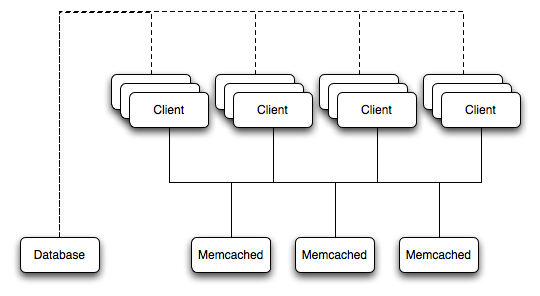[+/-]
The largest problem with scalability within a typical environment is the speed with which you can access information. For frequently accessed information, using MySQL can be slow because each access of information requires execution of the SQL query and recovery of the information from the database. This also means that queries on tables that are locked or blocking may delay your query and reduce the speed of recovery of information.
memcached is a simple, yet highly scalable key-based cache that stores data and objects wherever dedicated or spare RAM is available for very quick access by applications. To use, you run memcached on one or more hosts and then use the shared cache to store objects.Because each host's RAM is storing information, the access speed will be much faster than having to load the information from disk. This can provide a significant performance boost in retrieving data versus loading the data natively from a database. Also, because the cache is just a repository for information, you can use the cache to store any data, including complex structures that would normally require a significant amount of effort to create, but in a ready-to-use format, helping to reduce the load on your MySQL servers.
The typical usage environment is to modify your application so that information is read from the cache provided by memcached. If the information isn't in memcached, then the data is loaded from the MySQL database and written into the cache so that future requests for the same object benefit from the cached data.
For a typical deployment layout, see Figure 14.4, “memcached Architecture Overview”.
In the example structure, any of the clients can contact one of the memcached servers to request a given key. Each client is configured to talk to all of the servers shown in the illustration. Within the client, when the request is made to store the information, the key used to reference the data is hashed and this hash is then used to select one of the memcached servers. The selection of the memcached server takes place on the client before the server is contacted, keeping the process lightweight.
The same algorithm is used again when a client requests the same key. The same key will generate the same hash, and the same memcached server will be selected as the source for the data. Using this method, the cached data is spread among all of the memcached servers, and the cached information is accessible from any client. The result is a distributed, memory-based, cache that can return information, particularly complex data and structures, much faster than natively reading the information from the database.
The data held within a memcached server is never stored on disk (only in RAM, which means there is no persistence of data), and the RAM cache is always populated from the backing store (a MySQL database). If a memcached server fails, the data can always be recovered from the MySQL database, albeit at a slower speed than loading the information from the cache.


User Comments
Add your own comment.